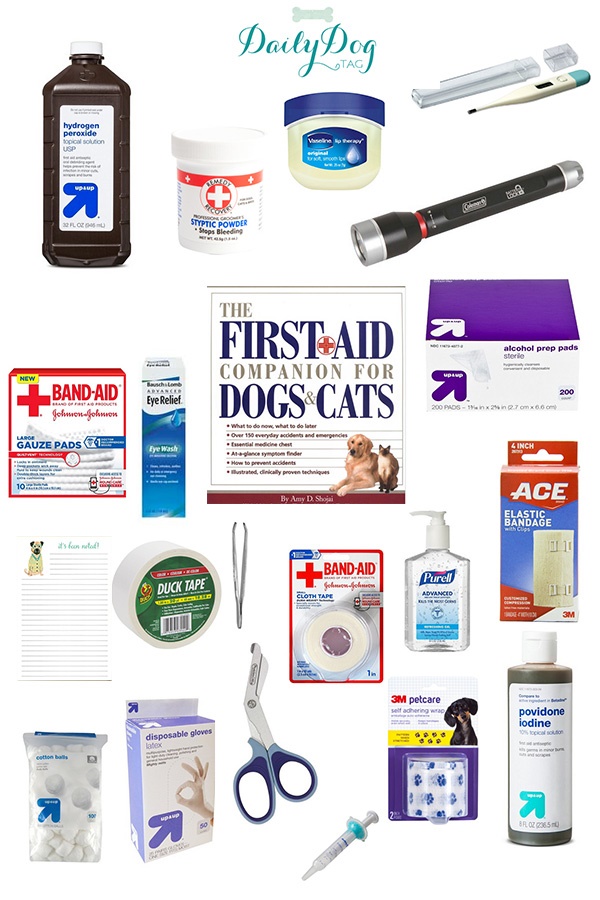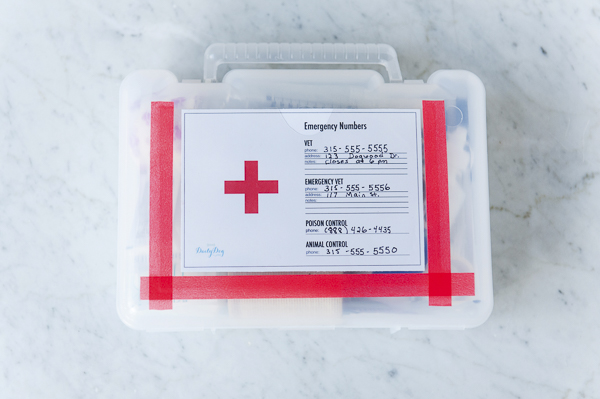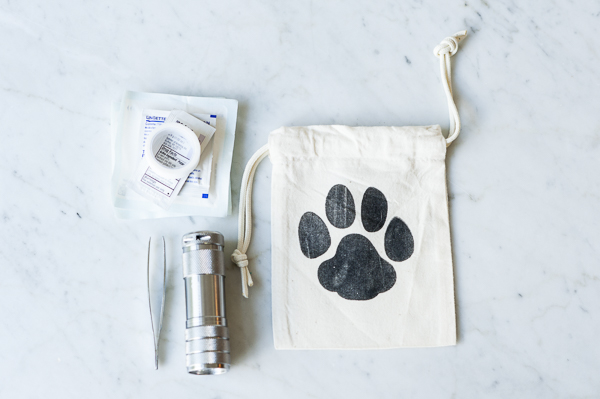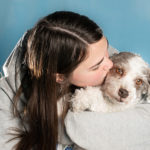Welcome to the first in a series of five guest posts here at the Daily Dog Tag aimed at helping you learn how to handle various kinds of pet problems and emergencies with your pet (not always the same thing). The series is called “Preparing Yourself and Your Pet for Emergencies.” While the advice will be most applicable to those who live with dogs and cats, there will also be some information that could apply to exotics or large animals.
Today’s guest post is the first in a series by Michael Salter from Springhill Associates. This post may contain affiliate links, meaning if you make a purchase, Daily Dog Tag will earn a small fee at no additional cost.
Preventing emergencies is the best way to start. Have your vet’s phone number handy, as well as the number for the closest after-hours emergency clinic and at least one pet-oriented poison control hotline (see below). If appropriate to your animal (such as a dog), seek out basic animal behavioral training. You can possibly save your pet’s life with just a few simple commands (“come,” “sit/stay,” “down,” “leave it”). Keep watch for environmental dangers when you’re outside with your pet. Be aware of “normal” behaviors, attitudes, appetites, water intakes, and urinary & bowel habits for your pet, and watch for changes. These are the first steps in preventing an emergency.
ASPCA Animal Poison Control Center (APCC) = 1 – 800 – 426 – 4435
Established in 1978 at the University of Illinois, the APCC can help save your pet’s life. This valuable service is supported by consultation fees, so you should have a credit card available when you call. This resource is available 24 hours a day, 365 days a year.
Daily Preparations and the First Aid Kits
In this installment, we’ll look at some average daily preparations you should have in place and some animal first aid kits.
First of all, here’s a list of standard daily preparations you should have on hand for your pet.
- Food, water, supplements as recommended by your vet, dish/bowl
- Litter, litter box, outdoor “pooper scooper,” plastic bags
- Collar, leash, muzzle
- License tag, identification tag (pet name, owner name & phone, vet name & phone)
- Copy of your pet’s vaccination records
- Identification microchip (consult your vet – have manufacturer’s name and phone number)
- Travel crate, cotton towels
- Phone numbers (vet, after-hours clinic, poison control center)
These items make daily life with your companion animal much easier. Knowing where to find the basic daily items gives peace of mind. And these items are the foundation of a comprehensive pet care strategy.
Each home with pets should keep some standard first aid items handy. There are also some good items to have with you when you are away from home with your companion animal, both for local travel and vacation. As has been said before, plan ahead.
Home First Aid kit contents:
- Emergency phone numbers
- Paper & pencil
- First aid books or information as specific to your pet as possible
- Flashlight
- Alcohol prep pads (for cleaning scissors, tweezers, and hands, NOT for pet wounds)
- Hand sanitizer (for cleaning your hands, NOT for your pet)
- Gloves (leather and vinyl/nitrile, for protecting hands and wounds from contamination)
- Adhesive tape
- Baby dose syringe (for flushing wounds, can also use a plastic bag with a hole in a corner)
- Cotton balls, swabs
- Elastic (ACE) bandage
- Eyewash (follow individual package directions)
- Duct tape
- Flexible wrap (aka “vet wrap”) (self-adhering, available in pet supply shops)
- Gauze pads, bandages, rolls (to clean, cushion, and cover wounds)
- Dog thermometer (non-contact or traditional style)
- Petroleum or water-based lubrication (for thermometer)
- Povidone-iodine solution (antiseptic, prevents infection in burns, lacerations, & abrasions)
- Scissors (cutting tape, gauze, and clipping hair around wounds)
- Tweezers
- Styptic pencil or powder (clotting agent to stop bleeding)
- Hydrogen peroxide (to induce vomiting under vet or poison control directions ONLY)
- Small towel
- Blanket or board
- Cloth strips (2 inches by 4 feet, can be used to secure animal to a board for transport)
That sounds like quite a bit of “stuff.” But most of it should fit in a one-gallon zipper-top plastic bag. Write the phone numbers on the outside of the bag with a Sharpie and cover the numbers with clear packing tape so they can’t smear. Or use a shoebox, a toolbox, a plastic storage tub, an inexpensive school-type book pack, or any other container that works for you. It should be reasonably portable in case of an evacuation emergency.
Local Travel:
For local travel with your pet (like a walk, trip to the dog park, or other activities), you’ll only need a few items. You will be with your pet, and they will be under your direct control, so you can prevent many issues before they happen.
- Leash, collar/harness, muzzle if appropriate
- Water and bowl, food if you’ll be out for an extended time
- Outdoor “pooper scooper” and related supplies (you know what you need)
- Emergency phone numbers
- Paper & pencil
- Hand sanitizer (for cleaning your hands, NOT for your pet)
- Gloves (leather and vinyl/nitrile, for protecting hands and wounds from contamination)
- Baby dose syringe (for flushing wounds, can also use a plastic bag with a hole in a corner)
- Elastic (ACE) bandage
- Flexible wrap (aka “vet wrap”) (self-adhering, available in pet supply shops)
- Gauze pads (to clean, cushion, and cover wounds)
- Scissors (cutting wrap, gauze, and clipping hair around wounds)
- Tweezers
- Styptic pencil or powder (clotting agent to stop bleeding)
- Small towel
- Travel crate or prepared pet section of the vehicle
For long-distance travel, such as a multi-day car trip or airline travel, you’ll need to take some specialized precautions and make some advance preparations. You will need your standard first aid kit plus a few extra items that are adapted to the method of travel.
Auto travel:
- Emergency phone numbers (your vet and emergency clinics on your route & destination)
- Leash, collar/harness, muzzle if appropriate
- Crate, bedding, food, water, and supplies
- Favorite toys
- Copies of vaccination and health records for your pet
Airline travel (same as auto travel, plus the following):
- Most important, contact the airline ahead of time. Discuss arrangements & security issues.
- Airline-approved crate with absorbent bedding.
- Tape a bag of extra food outside the crate in case of delays.
- Tape a spare leash and collar/harness to the outside of the crate as well.
- Consider sleeping in an old, soft t-shirt the night before flying and putting it inside the crate to help soothe your pet with a familiar scent.
No doubt about it, there’s extra work involved in traveling with your pet, even locally. But it certainly is worth the benefits for both yourself and your pet. Next time we will look at basic and general injury treatments.
Be sure to check out our DIY First Aid Kit for Dogs!
Springhill Associates is based in Georgetown, New York, and offers a range of services, including first aid training, wilderness skills, and assistance in writing grants.











Such helpful advice, thanks for sharing!
I think it’s such a great idea to write all the emergency numbers right on the container. I hadn’t thought of it, but sometimes when something goes wrong it’s hard to remember where to find those numbers.
I don’t do well in a panic situation, so I need all the help I can get!